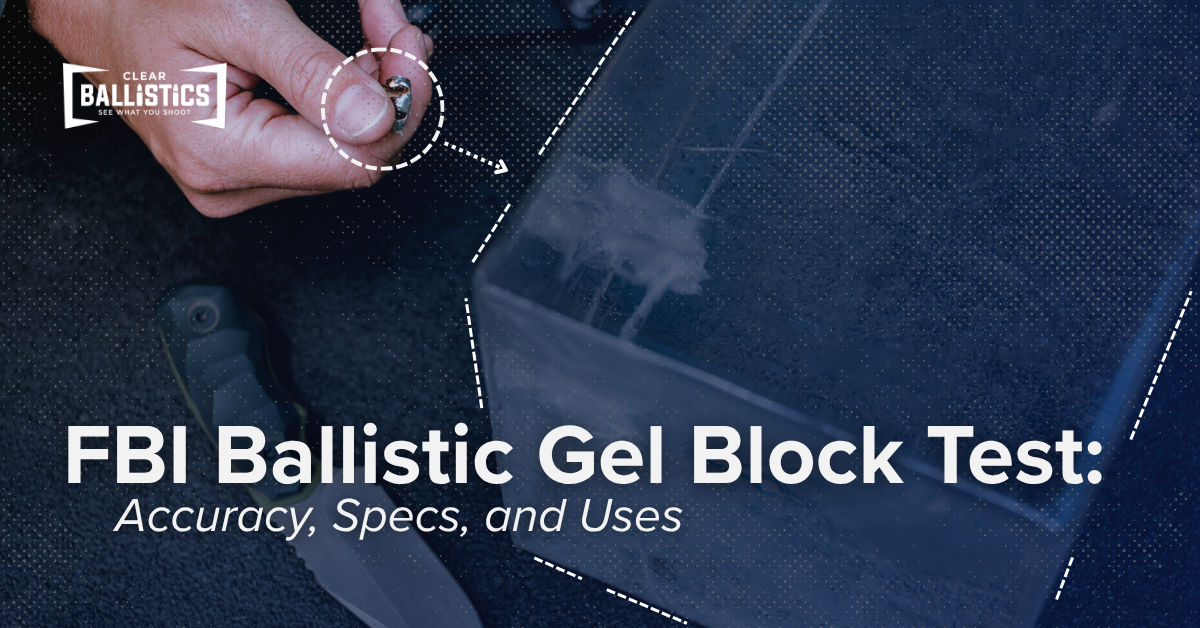You’ve never really understood your ammo until you’ve seen what it does in gel.
Paper targets show aim. Steel shows impact. But neither shows what happens after the hit. That’s where most testing falls short.
FBI ballistic gel gives you the full story. It’s a synthetic, calibrated medium that mimics real tissue. It shows exactly how your round penetrates, expands, and transfers energy. And it does this with repeatable clarity.
In this blog, you’ll learn why most ammo testing misses the mark. We’ll break down how FBI ballistic gel works, what makes it different, and how it’s used across law enforcement, firearms training, and product development. We’ll also show you why calibration matters and why Clear Ballistics is the trusted name in FBI-spec gel.
If you care about how your ammo performs, this is where real testing starts.
What is FBI Ballistic Gel and Why Does It Matter?
FBI ballistic gel is a synthetic medium that replicates the density and resistance of soft human tissue. It’s made using a precise 10 percent gelatin mix, following a standard created by the FBI to measure how ammunition behaves after impact.
Some shooters try to learn how to make ballistics gel at home, but without consistency and calibration, those tests fall short. The official ballistics gel recipe isn’t just about gelatin — it’s about precise control, preparation, and calibration. That’s what gives the FBI standard its credibility.
This matters because most testing tools only show surface results. Ballistic gel shows what your ammo does when it counts.
Why shooters use FBI ballistic gel:
- It replicates soft tissue. Every block is designed to simulate the real thing, without the mess or inconsistency of organic materials.
- It removes guesswork. You get visible proof of penetration, expansion, and energy transfer.
- It’s consistent. Made to a strict formula and tested for calibration, it gives results that can be trusted and compared.
- It’s transparent. Literally. You can see the wound track from any angle, which is critical for training, development, and education.
Professionals use it because it works. Law enforcement, ammo manufacturers, firearm instructors, and serious shooters trust it to give them more than a hit or a hole. It gives them the truth.
Why Traditional Ammo Testing Falls Short
Hitting your target is only part of the equation. Most shooters rely on paper or steel when testing ammunition, thinking that’s enough to understand performance. It’s not.
Traditional methods fall short because they only measure what happens before the round meets resistance. They can’t show what the bullet does after impact, which is where real performance begins.
Here’s why common testing methods don’t give you the full picture:
Testing method #1: Paper shows aim, not effect- You can measure accuracy and groupings, but not what the round does inside a target.
Testing method #2: Steel reacts with sound, not substance- It tells you a hit occurred, but not how the bullet expanded or transferred energy.
Testing method #3: Neither reveals terminal ballistics- You won’t see penetration depth, wound channel, or bullet deformation.
If your goal is performance, not just impact, ballistic gel is the tool that shows you what happens next.
When you rely on the wrong testing methods, critical decisions get based on guesswork. Here’s what that looks like:
- You can’t confirm if your ammo stops a threat. Defensive shooters need more than impact. They need proof of effectiveness.
- Manufacturers can’t refine without real data. Without consistent feedback, design improvements are guesswork.
- Instructors can’t teach what they can’t show. Students need to see what rounds do in a realistic medium, not just where they land.
What Makes FBI Ballistic Gel the Gold Standard
If you want data you can trust, the testing medium has to be consistent. That’s exactly why the FBI developed a clear standard. It uses a 10 percent gelatin formula that behaves like soft human tissue and holds up to repeatable testing.
Unlike theatrical gel filled with dye, fake organs, or gore, this standard wasn’t designed for shock value. It was built to reveal the truth about bullet performance.
Read on to see the difference.
The FBI formula is precise:
- 10% gelatin mix, measured by weight and kept at controlled temperatures to match soft tissue density.
- Calibrated using a steel BB, which must penetrate between 8.5 and 9.5 cm at a specific speed.
- Crystal clear blocks that make it easy to observe, photograph, and measure wound channels from any angle.
More than that, it’s consistent every time:
- Same density and preparation, no matter who’s testing or when.
- Lab-ready quality means data can be compared across teams, agencies, or product batches.
- Synthetic and stable, so you don’t deal with decay, mess, or variable results.
And most importantly, it’s honest:
- No red dye. No plastic bones. No theatrics.
- Just a clean, calibrated block that shows the true effect of your round inside soft tissue.
That’s why it became the industry benchmark — and why it’s still trusted by professionals today.
How the FBI Ballistic Gel Block Test Works
The FBI ballistic gel test simulates more than just tissue. It recreates the barriers a bullet might pass through in real-world scenarios. Each setup is designed to reflect a specific threat — from clothing to walls to glass — giving shooters and professionals a full picture of how a round performs in context.
Below are the six official steps in the FBI block test, each with a specific purpose.
Step 1: Bare Gel
This is the control test. The bullet passes through a clear block with no barriers. It shows how the round performs in soft tissue alone, with no interference. Penetration depth, expansion, and weight retention are all measured here to establish a baseline.
Step 2: Heavy Clothing
This step simulates multiple layers of thick clothing, including cotton, fleece, and denim. The bullet must pass through the fabric before entering the gel. This test shows whether expansion is delayed, disrupted, or consistent through real-world materials.
Step 3: Wallboard
To mimic interior drywall, two pieces of gypsum board are placed in front of the block. This setup tests how the bullet performs after passing through typical walls found in homes or offices.
Step 4: Plywood
This test adds a layer of structural challenge. A piece of three-quarter-inch plywood stands in for wooden doors or wall panels. It reveals whether the round can maintain integrity and direction after hitting construction-grade material.
Step 5: Steel
A sheet of 20-gauge steel, similar to what’s found in car doors or lockers, is placed in front of the gel. This is a high-impact test. It shows how bullets behave after hitting hard, dense surfaces, and whether they continue to expand or tumble inside the block.
Step 6: Auto Glass
Angled automotive glass simulates a windshield. The bullet must pass through at a slant, reflecting real-world vehicle scenarios. This test is one of the most challenging, as glass can cause fragmentation or deflection.
Each step builds on the last to create a full picture of terminal performance. These tests are especially revealing for popular defensive calibers. For example, 5.56 ballistics gel tests demonstrate how rifle rounds behave in realistic encounters.
Why Accuracy and Calibration Matter
Getting the shot is one thing. Getting valid results is another. Without proper calibration, even the best-looking gel block can give you false feedback.
Here’s why accuracy and calibration are non-negotiable.
Reason #1: Calibration proves consistency
Each FBI gel block is tested using a steel BB fired at 590 feet per second. That BB must penetrate between 8.5 and 9.5 centimeters. This single step confirms that the block simulates soft tissue correctly. If it falls outside the range, the block can’t be trusted.
Reason #2: Without calibration, your data is flawed
Shooting into uncalibrated gel is just shooting into Jell-O. You might get impressive visuals, but you won’t get real information. You can’t compare results. You can’t verify performance. And worst of all, you could be trusting a round that doesn’t actually work the way you think it does.
Reason #3: Environmental control matters too
Heat, cold, and humidity all affect gel behavior. Even with a perfect formula, poor storage or handling can change the way a block performs. That’s why professionals monitor conditions closely and always recalibrate before a test session.
Real testing demands precision. That’s what separates practice from proof.
Make the Switch to FBI-Calibrated Gel
The paper shows placement. Steel rings on contact. But none of it tells the full story.
FBI ballistic gel gives you more than a hit. It gives you clarity. It shows how your round moves, expands, and transfers energy through simulated soft tissue. It also reveals how it performs through barriers like drywall, clothing, or auto glass.
If you’re serious about understanding your ammo, testing with FBI-calibrated gel isn’t optional. It’s essential.
Explore FBI-Calibrated Gel Blocks from Clear Ballistics and start testing with purpose. Know what your role does. Not what you hope it does.

